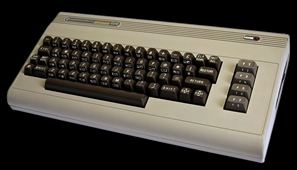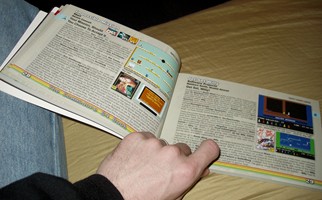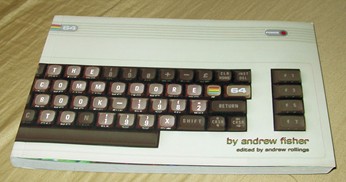 |
 |
| A virtual coffeehouse for
technological minds and ideas |
|
The Commodore 64 still has game!
For the benefit of
enthusiasts and others Andrew Fisher has written a book – "The Commodore 64 Book
1982-199x" – filled with reviews of Commodore 64 games. Electron
Café talked to him about the book, his history with the C64 and
his plans for the future. Q. In the 1980s what made up your mind to buy your own
computer and why did you decide on a Commodore 64? It actually came as a great surprise. My parents had been
talking about buying a computer for the house, since my older
brother and I were starting to come into contact with computers
regularly at school. So it was wonderful to come home from
shopping one Saturday morning to find a parcel containing a
Commodore 64 computer, tape deck and two games waiting on the
table. Some people may laugh at the phrase "We bought it to help
with your homework", immortalized in the song "Hey Hey 16K" by
MJ Hibbett, but that C64 really did – all three brothers did
homework and even exam coursework on the machine. Q. Can you describe your excitement and experience of buying
your first Commodore 64 computer? When you got it home what was the first thing you did with
it? Well, those two questions are closely linked, so I’ll answer
them together. That same afternoon with my father’s help we
tried to set up the machine on the TV. And this is where we hit
a problem – we tried to tune the picture in for ages, but we
were getting no output from the C64. With a rather large sigh my
father realized there was a problem, and so the machine was
packaged up and returned to Commodore for repair. It turned out
the power supply was faulty, and it took nearly a month to get
it back and working. The first games I ever played on the C64 were the two that
came bundled with the machine. One was Arcadia 64 by Imagine, a
single-screen shoot ‘em up that took 18 minutes to load (this
was in the days before fast loaders). Without a joystick it was
tricky to play, and the thing I remember most is the way the
display flickered as the programmer tried to throw lots of
enemies onscreen at once. The other game was 3D Time Trek,
programmed in BASIC and a typical "Star Trek" clone of the time
– explore the galaxy and destroy the enemies. The only
difference was the terrible "3D arcade battle sequence", which
was also joystick controlled. Saving up some pocket money, my
brother and I invested in a joystick (the incredibly solid Wico
Boss, with a metal shaft and one fire button on the top). I
borrowed a few games from a friend at school, including the
amazing Ghostbusters and Daley Thompson’s Decathlon, started
learning how to program in BASIC, and gradually became regarded
as a "computer expert" at school and among my friends. My father
enjoyed playing Leaderboard and Winter Games with us on Sunday
mornings, and my mother would eventually develop an addiction to
Tetris… Q. You recently completed a book about the C64 computer with
reviews of games that were made for it. What do you think
accounts for the fascination that you and many other people
still have for this computer even though many more powerful
computers and gaming consoles have come along since? The first thing is the diversity of the games themselves.
From simple arcade games to complex role-playing games and
adventures, there really is an amazing range. Myself, I play all
sorts – sports simulations, shoot ‘em ups, platform games, and
the occasional RPG. Many of the games remain playable today –
I’m thinking of classics like The Sentinel (known as The Sentry
in the USA), The Last Ninja and Wizball. I also spent many hours
playing Microprose Soccer with my brothers, even though it would
inevitably end up being a draw and go into the heartache of
extra time… The next reason is the investment of time and money into a
system. Yes, there are more powerful machines around, and I have
a large collection of games systems both new and old myself. But
back then I did not have the money to move on; it took me months
to save for my first disk drive, for example. In the early 1990s
I was given the choice of a brand-new Amiga, or another C64 with
disk drive. I stuck with the C64, I got a job writing freelance
for a computer magazine based on my knowledge of the C64, and
that set me on course to being a writer today. It’s taken me
from my bedroom in Cambridge, England to a retro concert in
Copenhagen. Finally, there’s the nostalgia aspect. You never forget your
first machine. The book is my attempt to put this all in
perspective, looking at the history of the industry (each
chapter starts with a brief introduction, talking about new
machines and the changes in the industry), and to show how
important the C64 was. After all, it was many people’s
introduction to the idea of having a computer in the house. I
also wanted to highlight a few of my personal favorite games,
and introduce one or two lesser-known titles to a wider
audience. The book has taken me a year to write, with fellow author and
Hiive Books founder Andrew Rollings (a Spectrum fan) working
alongside me as editor and designer. While there has always been
a great rivalry between Spectrum and C64 owners, I hope some of
them will be interested to read how the games were different on
the C64 and what they may have missed… Q. For someone who wants to get into retro gaming, and maybe
play some of the games in your book, what are the ways they can
get started? It’s fairly straightforward to get into retro gaming, thanks
to programs known as emulators. This is a small piece of
software that makes your modern machine behave like an old
computer (or console). Among the best options to emulate the
Commodore 64 are the VICE (Versatile Commodore Emulator, at
www.viceteam.org) and CCS64 (found at
http://www.computerbrains.com/ccs64/).
For Mac users, the shareware Power64 is your best bet. Of course, emulation will never give you the complete feeling
of using an old machine. For that you will need to hit the
online auction sites – but as ever, let the buyer beware. Check
that important items like cables and the power supply are
included. Another option is the C64DTV joystick, which plugs
straight into a TV and contains a good selection of 30 games. It
has a full version of BASIC, and ingenious hackers have added a
keyboard and disk drive to the joystick, turning it into a
fully-fledged machine. Q. There are actually still game development projects going
on for the C64. Can you describe some of these projects? Like a lot of old machines, there is a thriving homebrew
scene. One of the more ambitious projects that has been underway
for a while is a conversion of the Amiga classic Pinball Dreams.
A demo version of two tables has whetted the appetite. Sub
Hunter by Richard Bayliss and Frank Gasking is a multi-level
scrolling shoot ‘em up loosely based around an old VIC 20 game
(Sub Hunt), which is also looking good. Grubz is an amazing
Worms-style game, with up to four players at once (thanks to
Protovision’s four-player interface) and some very slick
background graphics. One of my personal favorites recently is
the preview of Zoo Mania, a puzzle game based on the DS classic
Zoo Keeper. There’s also still a large cracking scene, with the
crackers adding instructions and cheats to create "jewel"
versions – even fixing bugs in the original games themselves. Q. What programming methods are used for game development for
this platform? A lot of programmers now use cross-development – developing
on the PC/Mac and then porting the finished code across to a
real machine. Emulators can help development, but it is best to
test on the real thing. Working on a PC can help cut development
times as the final build can be assembled a lot quicker. Q. You still own and use your original C64 computer. Do you
fear the day it may stop working, and do you have a repair or
replacement plan if it does? I have two or three machines that are still working; the main
worry for me right now is working disk drives. I will be
shopping around to find more equipment in the near future, and
in the meantime I still have the emulators to fall back on. Q. Do you have any ideas you’re working on now to keep this
classic alive for the future? I run a website about a program called SEUCK, The Shoot ‘Em
Up Construction Kit, that allows people with little or no coding
knowledge to create their own games on the Commodore 64.
Versions were also created for the ST and Amiga, but one
limitation was that the screen could only scroll vertically (or
stay still for a number of seconds). The SEUCK Vault (www.seuckvault.co.uk)
has tips on using the program, articles, reviews and an archive
of games, some of them exclusive to the site. I am hoping to
expand the Amiga section soon, and the second anniversary of the
site has come with a very interesting announcement. Programmer
Jon Wells has modified the SEUCK editor to create horizontally
scrolling games, which should give the program a new lease of
life and inspire many new games. I am also involved in a couple
of other game projects that should be finished this year,
writing music and play-testing as well as helping with the game
design. Through my writing I also try to keep the spirit of the old
machine alive. My articles for Retro Gamer, for example, have
looked back at games like Rick Dangerous. Being in contact with
the programmers and hearing how the game was made was very
interesting for me, and I hope for the readers too. There are
plans for an Amiga games book in the Golden Years series that I
will be involved with, and a more general history book on the
Commodore 64. I will still be a Commodore 64 fan for many years
to come, particularly as the machine wants to live on –the
latest announcement being C64 games available for the Nintendo
Wii’s Virtual Console (in Europe initially). Twenty-five years
on, and the machine can still surprise me. "The Commodore 64 Book 1982-199x" from Hiive Books is
available from March 2008, with the website at
http://c64goldenyears.com the ONLY place to order - by PayPal or
credit card. The book is a follow-up to Andrew Rollings’
sold-out "The ZX Spectrum Book 1982-199x", and the second title
in the planned Golden Years series. The Commodore 64 Book
contains over 200 game reviews in full color, organized by year
into chapters, with the last chapter dealing with 1993-2008 as
the machine reached the end of the line commercially and the
homebrew scene took over. Each review page contains screenshots,
scans of the cover art, trivia about the people and companies
involved and a description of the gameplay. The book also comes
with a foreword by legendary games programmer Jeff Minter. Price
is £17.99 plus post & packing. Andrew Fisher got his first Commodore 64 in 1985, and in the
early 1990s began his career as a freelance writer for Commodore
Force (incorporating ZZAP! 64) before moving to the rival
Commodore Format. In recent years he has attended many retro
events, written for Retro Gamer and gamesTM, and organized
2005’s "Retro Survival" CD magazine. This is his first book.
|
add to favorites
|
 del.icio.us
del.icio.us
 Slashdot It!
Slashdot It!
 Stumble It!
Stumble It!
Home | About Us | Advertise | Submit an Article | Submit a Link | Contact Us
ElectronCafé.com is a registered property of electricalfun.com Copyright © 2008 - All rights reserved
 If you didn't grow up during the 1980s it might be hard
to fully understand the excitement and enthusiasm that still exists
for a 25 year old computer with an 8-bit processor running at 1.02 MHz.
The graphics don't compare with the near cinema quality
generated by today's powerful machines, but there's a nostalgia
to them - and a love for the C64 - that can't be beaten by
processing power or polygon rates.
If you didn't grow up during the 1980s it might be hard
to fully understand the excitement and enthusiasm that still exists
for a 25 year old computer with an 8-bit processor running at 1.02 MHz.
The graphics don't compare with the near cinema quality
generated by today's powerful machines, but there's a nostalgia
to them - and a love for the C64 - that can't be beaten by
processing power or polygon rates. It’s simply a matter of downloading and running the emulator,
and giving it a game file to play. These are commonly disk
images (a D64 file) or a tape image (TAP or T64). If you find a
game as a TAP file, it is a direct dump of the original tape
itself, so playing it in the emulator will give you the loading
screen, music and so on, perfectly recreating the experience of
loading the game from tape. One of the best sources for games is
Gamebase64, at
It’s simply a matter of downloading and running the emulator,
and giving it a game file to play. These are commonly disk
images (a D64 file) or a tape image (TAP or T64). If you find a
game as a TAP file, it is a direct dump of the original tape
itself, so playing it in the emulator will give you the loading
screen, music and so on, perfectly recreating the experience of
loading the game from tape. One of the best sources for games is
Gamebase64, at  ABOUT THE BOOK:
ABOUT THE BOOK: ABOUT THE AUTHOR:
ABOUT THE AUTHOR: